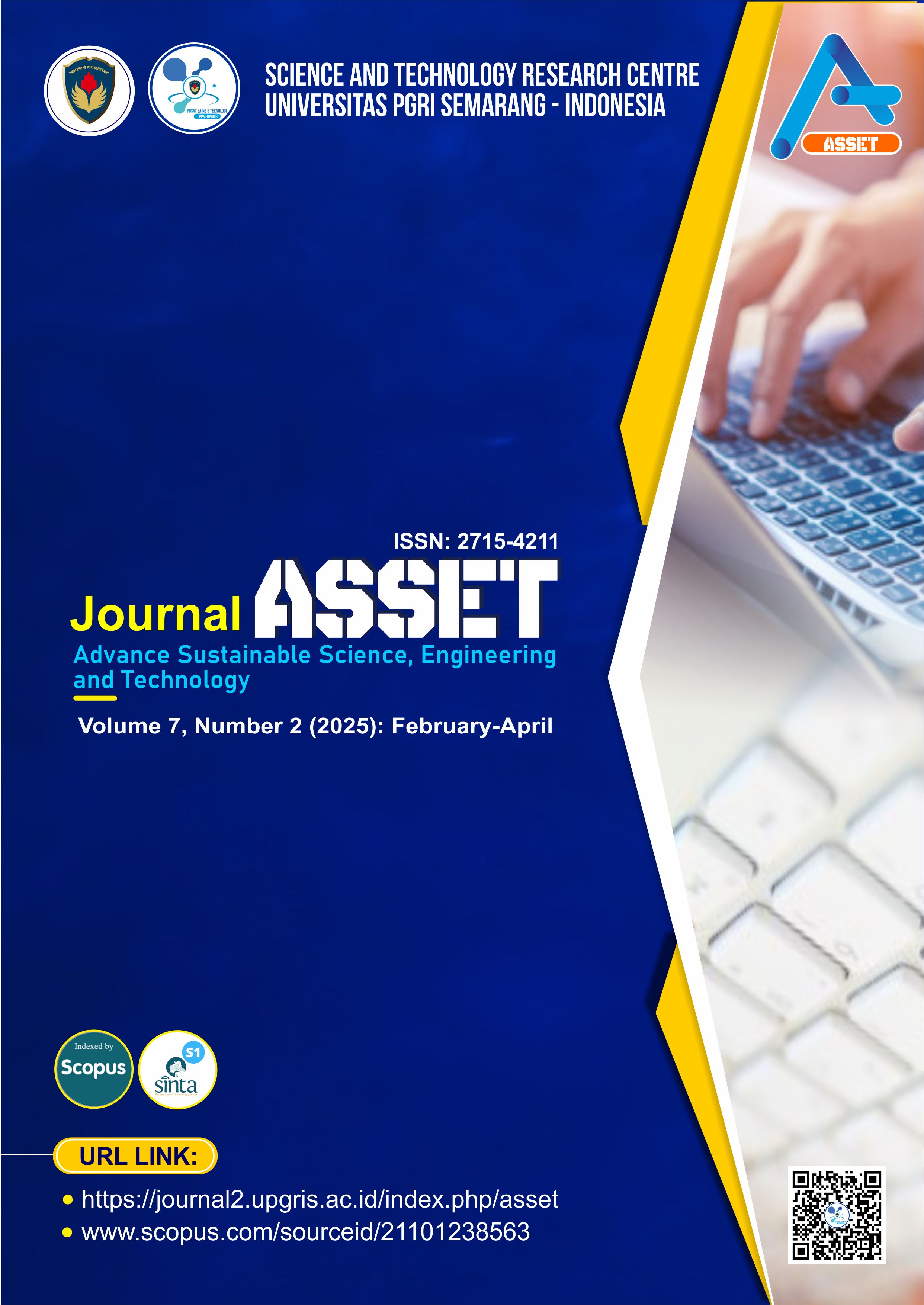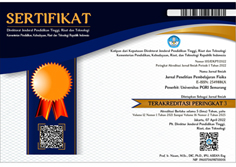Adaptive Learning Systems for Data Conversion in EHRs through Machine Learning
DOI:
https://doi.org/10.26877/aqvgnq17Keywords:
machine learning, transfer learning, deep learning, fine-tuningAbstract
Healthcare data management has advanced with Electronic Health Records (EHRs), enhancing the efficiency of medical procedures. Machine learning applied to EHRs transitions healthcare from reactive to proactive, supporting the cost-efficiency and sustainability goals of smart cities. However, digitizing medical records introduces security risks, especially from internal threats, necessitating strong detection systems. Research into machine learning techniques, such as decision trees, random forests, and support vector machines (SVMs), shows their effectiveness in detecting EHR breaches. Balancing system usability with patient privacy remains a key challenge amid widespread data sharing. This study highlights SVMs and deep learning models as promising for improving EHR data accuracy, enhancing detection efficiency, and supporting clinical decisions. Despite advancements in AI, deep learning continues to play a crucial role in refining clinical decision systems, including translating EHR data using technologies like natural language processing (NLP). The study provides a qualitative analysis of how deep learning can optimize EHR processes while addressing security and functional challenges.
References
[1] R. Tertulino, N. Antunes, and H. Morais, “Privacy in electronic health records: a systematic mapping study,” Journal of Public Health, Jan. 2023, doi: 10.1007/s10389-022-01795-z. Available: https://doi.org/10.1007/s10389-022-01795-z.
[2] J. Pool, S. Akhlaghpour, F. Fatehi, and A. Burton-Jones, “A systematic analysis of failures in protecting personal health data: A scoping review,” International Journal of Information Management, vol. 74, p. 102719, Feb. 2024, doi: 10.1016/j.ijinfomgt.2023.102719. Available: https://doi.org/10.1016/j.ijinfomgt.2023.102719 .
[3] W. Xu, Q. Zhao, Y. Zhan, B. Wang, and Y. Hu, “Privacy-preserving association rule mining based on electronic medical system,” Wireless Networks, vol. 28, no. 1, pp. 303–317, Jan. 2022, doi: 10.1007/s11276-021-02846-1. Available: https://doi.org/10.1007/s11276-021-02846-1.
[4] J. R. A. Solares et al., “Deep learning for electronic health records: A comparative review of multiple deep neural architectures,” Journal of Biomedical Informatics, vol. 101, p. 103337, Jan. 2020, doi: 10.1016/j.jbi.2019.103337. Available: https://doi.org/10.1016/j.jbi.2019.103337 .
[5] P. K. Kannoju, K. V. Sridhar, and K. S. R. Prasad, “A new paradigm of electronic health record for efficient implementation of health care delivery,” Second International Conference on Intelligent Systems, Modelling and Simulation., Jan. 2011, doi: 10.1109/isms.2011.28. Available: https://doi.org/10.1109/isms.2011.28.
[6] J. Pool, S. Akhlaghpour, F. Fatehi, and A. Burton-Jones, “A systematic analysis of failures in protecting personal health data: A scoping review,” International Journal of Information Management, vol. 74, p. 102719, Feb. 2024, doi: 10.1016/j.ijinfomgt.2023.102719. Available: https://doi.org/10.1016/j.ijinfomgt.2023.102719
[7] W. Xu, Q. Zhao, Y. Zhan, B. Wang, and Y. Hu, “Privacy-preserving association rule mining based on electronic medical system,” Wireless Networks, vol. 28, no. 1, pp. 303–317, Jan. 2022, doi: 10.1007/s11276-021-02846-1. Available: https://doi.org/10.1007/s11276-021-02846-1.
[8] J. Xu, X. Xi, J. Chen, V. S. Sheng, J. Ma, and Z. Cui, “A survey of deep learning for electronic health records,” Applied Sciences, vol. 12, no. 22, p. 11709, Nov. 2022, doi: 10.3390/app122211709. Available: https://doi.org/10.3390/app122211709.
[9] J. Ke, W. Wang, X. Chen, J. Gou, Y. Gao, and S. Jin, “Medical entity recognition and knowledge map relationship analysis of Chinese EMRs based on improved BiLSTM-CRF,” Computers & Electrical Engineering, vol. 108, p. 108709, May 2023, doi: 10.1016/j.compeleceng.2023.108709. Available: https://doi.org/10.1016/j.compeleceng.2023.108709.
[10] H. Chen, H. Li, G. Xu, Y. Zhang, and X. Luo, “Achieving privacy-preserving federated learning with irrelevant updates over E-Health applications,” IEEE Xplore, Jun. 2020, doi: 10.1109/icc40277.2020.9149385. Available: https://doi.org/10.1109/icc40277.2020.9149385.
[11] M. M. M. Pai, R. Ganiga, R. M. Pai, and R. K. Sinha, “Standard electronic health record (EHR) framework for Indian healthcare system,” Health Services and Outcomes Research Methodology, vol. 21, no. 3, pp. 339–362, Jan. 2021, doi: 10.1007/s10742-020-00238-0. Available: https://doi.org/10.1007/s10742-020-00238-0.
[12] A. Mukherjee, “Implementing Electronic Health Records in India: Status, Issues & Way Forward,” Biomedical Journal of Scientific & Technical Research, vol. 33, no. 2, Jan. 2021, doi: 10.26717/bjstr.2021.33.005378. Available: https://doi.org/10.26717/bjstr.2021.33.005378 .
[13] A. O. Ugwu, X. Gao, J. O. Ugwu, and V. Chang, “Ethical Implications of AI in Healthcare Data: A Case Study Using Healthcare Data Breaches from the US Department of Health and Human Services Breach Portal between 2009-2021,” IEEE Xplore, Sep. 2022, doi: 10.1109/iiotbdsc57192.2022.00070. Available: https://doi.org/10.1109/iiotbdsc57192.2022.00070.
[14] S. Kohler et al., “Eos and OMOCL: Towards a seamless integration of openEHR records into the OMOP Common Data Model,” Journal of Biomedical Informatics, vol. 144, p. 104437, Aug. 2023, doi: 10.1016/j.jbi.2023.104437. Available: https://doi.org/10.1016/j.jbi.2023.104437.
[15] R. Y. Patil, “A secure privacy preserving and access control scheme for medical internet of things (MIoT) using attribute-based signcryption,” International Journal of Information Technology, vol. 16, no. 1, pp. 181–191, Oct. 2023, doi: 10.1007/s41870-023-01569-0. Available: https://doi.org/10.1007/s41870-023-01569-0.
[16] T. D. Sequist, T. Cullen, H. Hays, M. M. Taualii, S. R. Simon, and D. W. Bates, “Implementation and Use of an Electronic Health Record within the Indian Health Service,” Journal of the American Medical Informatics Association, vol. 14, no. 2, pp. 191–197, Mar. 2007, doi: 10.1197/jamia.m2234. Available: https://doi.org/10.1197/jamia.m2234 .
[17] R. Hoover, “Benefits of using an electronic health record,” Nursing Critical Care, vol. 12, no. 1, pp. 9–10, Jan. 2017, doi: 10.1097/01.ccn.0000508631.93151.8d. Available: https://doi.org/10.1097/01.ccn.0000508631.93151.8d.
[18] H. Li et al., “Review on security of federated learning and its application in healthcare,” Future Generation Computer Systems, vol. 144, pp. 271–290, Jul. 2023, doi: 10.1016/j.future.2023.02.021. Available: https://doi.org/10.1016/j.future.2023.02.021.
[19] K.-L. Tan, C.-H. Chi, and K.-Y. Lam, “Secure and privacy-preserving sharing of personal health records with multi-party pre-authorization verification,” Wireless Networks, Sep. 2022, doi: 10.1007/s11276-022-03114-6. Available: https://doi.org/10.1007/s11276-022-03114-6.
[20] S. Cao, Q. Zhang, D. Wang, P. Xiangli, and X. Zhang, “Hybrid smart contracts for Privacy-Preserving-Aware Insurance compensation,” 2022 IEEE Wireless Communications and Networking Conference (WCNC), Apr. 2022, doi: 10.1109/wcnc51071.2022.9771976. Available: https://doi.org/10.1109/wcnc51071.2022.9771976.
[21] M. Ciampi, M. Sicuranza, and S. Silvestri, “A Privacy-Preserving and Standard-Based architecture for secondary use of clinical data,” Information, vol. 13, no. 2, p. 87, Feb. 2022, doi: 10.3390/info13020087. Available: https://doi.org/10.3390/info13020087.
[22] J. Zhang, J. Zhang, K. Wang, and W. Yan, “Should doctors use or avoid medical terms? The influence of medical terms on service quality of E-health,” Electronic Commerce Research, vol. 23, no. 3, pp. 1775–1805, Oct. 2021, doi: 10.1007/s10660-021-09516-6. Available: https://doi.org/10.1007/s10660-021-09516-6.
[23] “Y. Luo, Z. Liu, and Q. Liu, “Deep stable representation learning on electronic health records,” 2022 IEEE International Conference on Data Mining (ICDM), Nov. 2022, doi: 10.1109/icdm54844.2022.00134. Available: https://doi.org/10.1109/icdm54844.2022.00134.
[24] C. Thapa and S. Camtepe, “Precision health data: Requirements, challenges and existing techniques for data security and privacy,” Computers in Biology and Medicine, vol. 129, p. 104130, Feb. 2021, doi: 10.1016/j.compbiomed.2020.104130. Available: https://doi.org/10.1016/j.compbiomed.2020.104130.
[25] Z. Zhu, J. Li, Q. Zhao, Y.-C. Wei, and Y. Jia, “Medical named entity recognition of Chinese electronic medical records based on stacked Bidirectional Long Short-Term Memory,” , IEEE 45th Annual Computers, Software, and Applications Conference (COMPSAC), Jul. 2021, doi: 10.1109/compsac51774.2021.00293. Available: https://doi.org/10.1109/compsac51774.2021.00293.)
[26] “M. J. Page et al., “The PRISMA 2020 statement: an updated guideline for reporting systematic reviews,” BMJ, p. n71, Mar. 2021, doi: 10.1136/bmj.n71. Available: https://doi.org/10.1136/bmj.n71.
[27] T. Ferté, S. Cossin, T. Schaeverbeke, T. Barnetche, V. Jouhet, and B. Hejblum, “Automatic phenotyping of electronical health record: PheVis algorithm,” Journal of Biomedical Informatics, vol. 117, p. 103746, May 2021, doi: 10.1016/j.jbi.2021.103746. Available: https://inria.hal.science/hal-03100435.
[28] “Y. Su, Y. Li, K. Zhang, and B. Yang, “A privacy-preserving public integrity check scheme for outsourced EHRs,” Information Sciences, vol. 542, pp. 112–130, Jan. 2021, doi: 10.1016/j.ins.2020.06.043. Available: https://doi.org/10.1016/j.ins.2020.06.043.
[29] “F. Zerka et al., “Systematic Review of Privacy-Preserving Distributed Machine Learning from Federated Databases in Health Care,” JCO Clinical Cancer Informatics, no. 4, pp. 184–200, Nov. 2020, doi: 10.1200/cci.19.00047. Available: https://doi.org/10.1200/cci.19.00047.
[30] J. L. Leevy, T. M. Khoshgoftaar, and F. Villanustre, “Survey on RNN and CRF models for de-identification of medical free text,” Journal of Big Data, vol. 7, no. 1, Sep. 2020, doi: 10.1186/s40537-020-00351-4. Available: https://doi.org/10.1186/s40537-020-00351-4.
[31] “Z. Ahmed, K. Mohamed, S. Zeeshan, and X. Dong, “Artificial intelligence with multi-functional machine learning platform development for better healthcare and precision medicine,” Database, vol. 2020, Jan. 2020, doi: 10.1093/database/baaa010. Available: https://doi.org/10.1093/database/baaa010 .
[32] “H. Ji, S. Kim, S. Yi, H. Hwang, J.-W. Kim, and S. Yoo, “Converting clinical document architecture documents to the common data model for incorporating health information exchange data in observational health studies: CDA to CDM,” Journal of Biomedical Informatics, vol. 107, p. 103459, Jul. 2020, doi: 10.1016/j.jbi.2020.103459. Available: https://doi.org/10.1016/j.jbi.2020.103459.
[33] D. Zhang, C. Yin, J. Zeng, X. Yuan, and P. Zhang, “Combining structured and unstructured data for predictive models: a deep learning approach,” medRxiv (Cold Spring Harbor Laboratory), Aug. 2020, doi: 10.1101/2020.08.10.20172122. Available: https://doi.org/10.1101/2020.08.10.20172122.
[34] R. Catelli, F. Gargiulo, V. Casola, G. De Pietro, H. Fujita, and M. Esposito, “A novel COVID-19 data set and an effective deep learning approach for the De-Identification of Italian medical records,” IEEE Access, vol. 9, pp. 19097–19110, Jan. 2021, doi: 10.1109/access.2021.3054479. Available: https://doi.org/10.1109/access.2021.3054479.
[35] L. O. Varela et al., “Evaluation of interventions to improve electronic health record documentation within the inpatient setting: a protocol for a systematic review,” Systematic Reviews, vol. 8, no. 1, Feb. 2019, doi: 10.1186/s13643-019-0971-2. Available: https://doi.org/10.1186/s13643-019-0971-2.
[36] R. H. Epstein, F. Dexter, and E. S. Schwenk, “Provider access to legacy electronic anesthesia records following implementation of an electronic health record system,” Journal of Medical Systems, vol. 43, no. 5, Mar. 2019, doi: 10.1007/s10916-019-1232-6. Available: https://doi.org/10.1007/s10916-019-1232-6.
[37] C. A. Nelson, A. J. Butte, and S. E. Baranzini, “Integrating biomedical research and electronic health records to create knowledge based biologically meaningful machine readable embeddings,” bioRxiv (Cold Spring Harbor Laboratory), Feb. 2019, doi: 10.1101/540963. Available: https://doi.org/10.1101/540963.
[38] D. A. Kumar and A. Chinnalagu, “Sentiment and Emotion in Social Media COVID-19 Conversations: SAB-LSTM Approach,” IEEE Xplore, Dec. 2020, doi: 10.1109/smart50582.2020.9337098. Available: https://doi.org/10.1109/smart50582.2020.9337098.
[39] Y. Yang, X. Zheng, W. Guo, X. Liu, and V. Chang, “Privacy-preserving fusion of IoT and big data for e-health,” Future Generation Computer Systems, vol. 86, pp. 1437–1455, Sep. 2018, doi: 10.1016/j.future.2018.01.003. Available: https://doi.org/10.1016/j.future.2018.01.003.
[40] N. M. Jagirdar, “Online Machine Learning Algorithms Review and Comparison in Healthcare,” University of Tennessee, Knoxville TRACE: Tennessee Research and Creative Exchange., Jan. 2018, Available: https://trace.tennessee.edu/cgi/viewcontent.cgi?article=6803&context=utk_gradthes.
[41] C. Xiao, E. Choi, and J. Sun, “Opportunities and challenges in developing deep learning models using electronic health records data: a systematic review,” Journal of the American Medical Informatics Association, vol. 25, no. 10, pp. 1419–1428, Jun. 2018, doi: 10.1093/jamia/ocy068. Available: https://doi.org/10.1093/jamia/ocy068.
[42] S. K. Nayak and S. Tripathy, “Privacy Preserving Provable Data Possession for Cloud Based Electronic Health Record System,” 2016 IEEE., Aug. 2016, doi: 10.1109/trustcom.2016.0149. Available: https://doi.org/10.1109/trustcom.2016.0149.
[43] J. Zhao, P. Papapetrou, L. Asker, and H. Boström, “Learning from heterogeneous temporal data in electronic health records,” Journal of Biomedical Informatics, vol. 65, pp. 105–119, Jan. 2017, doi: 10.1016/j.jbi.2016.11.006. Available: https://doi.org/10.1016/j.jbi.2016.11.006.
[44]Y. Chen, S. Nyemba, W. Zhang, and B. Malin, “Leveraging social networks to detect anomalous insider actions in collaborative environments,” , IEEE Xplore, Jul. 2011, doi: 10.1109/isi.2011.5984061. Available: https://doi.org/10.1109/isi.2011.5984061.
[45] Z. Jiang, C. Zhao, B. He, Y. Guan, and J. Jiang, “De-identification of medical records using conditional random fields and long short-term memory networks,” Journal of Biomedical Informatics, vol. 75, pp. S43–S53, Nov. 2017, doi: 10.1016/j.jbi.2017.10.003. Available: https://doi.org/10.1016/j.jbi.2017.10.003.
[46] S. El-Gendy, M. S. Elsayed, A. Jurcut, and M. A. Azer, “Privacy preservation using machine learning in the internet of things,” Mathematics, vol. 11, no. 16, p. 3477, Aug. 2023, doi: 10.3390/math11163477. Available: https://doi.org/10.3390/math11163477.
[47] J. G, S. R, G. H. L, V. Ravi, M. Almeshari, and Y. Alzamil, “Electronic Health Record (EHR) system development for study on EHR data-based early prediction of diabetes using machine learning algorithms,” The Open Bioinformatics Journal, vol. 16, no. 1, Oct. 2023, doi: 10.2174/18750362-v16-e230906-2023-15. Available: https://doi.org/10.2174/18750362-v16-e230906-2023-15.
[48] A. Kline et al., “Multimodal machine learning in precision health: A scoping review,” Npj Digital Medicine, vol. 5, no. 1, Nov. 2022, doi: 10.1038/s41746-022-00712-8. Available: https://doi.org/10.1038/s41746-022-00712-8.
[49] K. V. Kanimozhi and Dr. M. Venkatesan, “Unstructured Data Analysis-A Survey,” IJARCCE, pp. 223–225, Mar. 2015, doi: 10.17148/ijarcce.2015.4354. Available: https://doi.org/10.17148/ijarcce.2015.4354.
[50] M. Zheng, H. Xue, Y. Zhang, T. Wei, and J. C. S. Lui, “Enpublic Apps,” Computer Science Raleigh, North Carolina., Apr. 2015, doi: 10.1145/2714576.2714593. Available: https://doi.org/10.1145/2714576.2714593.
[51] L. M. Dang, Md. J. Piran, D. Han, K. Min, and H. Moon, “A survey on internet of things and cloud computing for healthcare,” Electronics, vol. 8, no. 7, p. 768, Jul. 2019, doi: 10.3390/electronics8070768. Available: https://doi.org/10.3390/electronics8070768.
[52] P. Tasatanattakool and C. Techapanupreeda, “User authentication algorithm with role-based access control for electronic health systems to prevent abuse of patient privacy,” 3rd IEEE International Conference on Computer and Communications (ICCC)., Dec. 2017, doi: 10.1109/compcomm.2017.8322697. Available: https://doi.org/10.1109/compcomm.2017.8322697.
[53] B. F. Smaradottir, “Security Management in Electronic Health Records: Attitudes and Experiences Among Health Care Professionals,” 2018 International Conference on Computational Science and Computational Intelligence (CSCI)., Dec. 2018, doi: 10.1109/csci46756.2018.00143. Available: https://doi.org/10.1109/csci46756.2018.00143.
[54] Q. Mamun and M. Rana, “A robust authentication model using multi-channel communication for eHealth systems to enhance privacy and security,” Electronics and Mobile Communication Conference (IEMCON)., Oct. 2017, doi: 10.1109/iemcon.2017.8117210. Available: https://doi.org/10.1109/iemcon.2017.8117210.
[55] A. Odeh, I. Keshta, A. Aboshgifa, and E. Abdelfattah, “Privacy and security in mobile health Technologies: Challenges and concerns,” 2022 IEEE 12th Annual Computing and Communication Workshop and Conference (CCWC), Jan. 2022, doi: 10.1109/ccwc54503.2022.9720863. Available: https://doi.org/10.1109/ccwc54503.2022.9720863.
[56] J. Ker, L. Wang, J. Rao, and T. Lim, “Deep learning applications in medical image analysis,” IEEE Access, vol. 6, pp. 9375–9389, Jan. 2018, doi: 10.1109/access.2017.2788044. Available: https://doi.org/10.1109/access.2017.2788044.
[57] X. Xu, T. Wang, Y. Yang, L. Zuo, F. Shen, and H. T. Shen, “Cross-Modal attention with semantic consistence for Image–Text matching,” IEEE Transactions on Neural Networks and Learning Systems, vol. 31, no. 12, pp. 5412–5425, Dec. 2020, doi: 10.1109/tnnls.2020.2967597. Available: https://doi.org/10.1109/tnnls.2020.2967597.
[58] J. Wallcraft et al., “Partnerships for better mental health worldwide: WPA recommendations on best practices in working with service users and family carers,” World Psychiatry, vol. 10, no. 3, pp. 229–236, Oct. 2011, doi: 10.1002/j.2051-5545.2011.tb00062.x. Available: https://doi.org/10.1002/j.2051-5545.2011.tb00062.x .
[59] J. Collmann and T. Cooper, “Breaching the Security of the Kaiser Permanente Internet Patient Portal: the Organizational Foundations of Information Security,” Journal of the American Medical Informatics Association, vol. 14, no. 2, pp. 239–243, Mar. 2007, doi: 10.1197/jamia.m2195. Available: https://doi.org/10.1197/jamia.m2195.”
[60] Y. Dong, X. Chen, L. Shen, and D. Wang, “Privacy-Preserving distributed machine learning based on secret sharing,” in Lecture notes in computer science, 2020, pp. 684–702. doi: 10.1007/978-3-030-41579-2_40. Available: https://doi.org/10.1007/978-3-030-41579-2_40.
[61] T. Wu, C. Zhao, and Y.-J. A. Zhang, “Privacy-Preserving distributed optimal power flow with partially homomorphic encryption,” IEEE Transactions on Smart Grid, vol. 12, no. 5, pp. 4506–4521, Sep. 2021, doi: 10.1109/tsg.2021.3084934. Available: https://doi.org/10.1109/tsg.2021.3084934.
[62] S. Meftah, B. H. M. Tan, C. F. Mun, K. M. M. Aung, B. Veeravalli, and V. Chandrasekhar, “DOReN: Toward Efficient Deep Convolutional Neural Networks with Fully Homomorphic Encryption,” IEEE Transactions on Information Forensics and Security, vol. 16, pp. 3740–3752, Jan. 2021, doi: 10.1109/tifs.2021.3090959. Available: https://doi.org/10.1109/tifs.2021.3090959.
[63] J. Zhang, H. Liu, and L. Ni, “A secure Energy-Saving communication and encrypted storage model based on RC4 for EHR,” IEEE Access, vol. 8, pp. 38995–39012, Jan. 2020, doi: 10.1109/access.2020.2975208. Available: https://doi.org/10.1109/access.2020.2975208.
[64] K. Rabieh, K. Akkaya, U. Karabiyik, and J. Qamruddin, “A secure and cloud-based medical records access scheme for on-road emergencies,” 15th IEEE Annual Consumer Communications & Networking Conference (CCNC), Jan. 2018, doi: 10.1109/ccnc.2018.8319175. Available: https://doi.org/10.1109/ccnc.2018.8319175.
[65] M. F. F. Khan and K. Sakamura, “A distributed approach to delegation of access rights for electronic health records,” 2020 International Conference on Electronics, Information, and Communication (ICEIC), Jan. 2020, doi: 10.1109/iceic49074.2020.9051092. Available: https://doi.org/10.1109/iceic49074.2020.9051092.
[66] Y. Zhang, C. Xu, X. Liang, H. Li, Y. Mu, and X. Zhang, “Efficient Public Verification of Data Integrity for Cloud Storage Systems from Indistinguishability Obfuscation,” IEEE Transactions on Information Forensics and Security, vol. 12, no. 3, pp. 676–688, Mar. 2017, doi: 10.1109/tifs.2016.2631951. Available: https://doi.org/10.1109/tifs.2016.2631951.
[67] I. S. Abdulhameed, I. Al-Mejibli, and J. R. Naif, “Improving security and privacy for health information and images,” Webology, vol. 19, no. 1, pp. 2435–2457, Jan. 2022, doi: 10.14704/web/v19i1/web19164. Available: https://doi.org/10.14704/web/v19i1/web19164.
[68] S. K. Nayak and S. Tripathy, “Privacy Preserving Provable Data Possession for Cloud Based Electronic Health Record System,” IEEE Trustcom/ BigDataSE/ISPA, Aug 2016, Pp. 860–867., Aug. 2016, doi: 10.1109/trustcom.2016.0149. Available: https://doi.org/10.1109/trustcom.2016.0149.
[69] S. Chenthara, K. Ahmed, H. Wang, and F. Whittaker, “Security and Privacy-Preserving challenges of e-Health solutions in cloud Computing,” IEEE Access, vol. 7, pp. 74361–74382, Jan. 2019, doi: 10.1109/access.2019.2919982. Available: https://doi.org/10.1109/access.2019.2919982.
[70] P. C. Tang and C. J. McDonald, “Electronic health record systems,” in Computers in health care, 2006, pp. 447–475. doi: 10.1007/0-387-36278-9_12. Available: https://doi.org/10.1007/0-387-36278-9_12.
[71] J. Vijayashree and H. P. Sultana, “A Machine Learning Framework for Feature Selection in Heart Disease Classification Using Improved Particle Swarm Optimization with Support Vector Machine Classifier,” Programming and Computer Software, vol. 44, no. 6, pp. 388–397, Nov. 2018, doi: 10.1134/s0361768818060129. Available: https://doi.org/10.1134/s0361768818060129.
[72] J. Vijayashree and H. P. Sultana, “Heart disease classification using hybridized Ruzzo-Tompa memetic based deep trained Neocognitron neural network,” Health and Technology, vol. 10, no. 1, pp. 207–216, Jan. 2019, doi: 10.1007/s12553-018-00292-2. Available: https://doi.org/10.1007/s12553-018-00292-2











